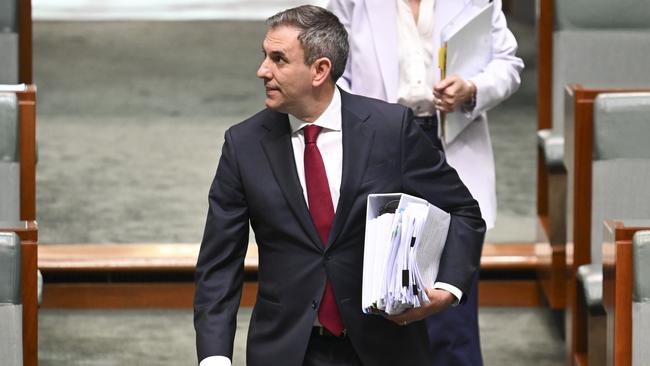Jim Chalmers unveils $900m play to push states and territories on productivity
State and territory governments are set to vie for $900m in federal funding to advance productivity-enhancing reforms, as the rapid expansion of the care economy threatens to exacerbate Australia’s productivity malaise.

State and territory governments will compete for $900m in federal funding to advance productivity enhancing reforms, as the rapid expansion of the care economy threatens to worsen Australia’s productivity malaise.
In an address in Sydney on Wednesday, Jim Chalmers will unveil a new National Productivity Fund, in conjunction with Labor’s wider efforts to arrest Australia’s recent run of weak productivity growth, with the Treasurer describing the challenge as the government’s “highest priority” for reform.
“There is no more important structural problem in our economy than productivity,” Dr Chalmers will tell a luncheon hosted by the Australian Business Economists network.
Under the plan, state and territory governments will be eligible to receive support for implementing a series of predetermined productivity-boosting measures, such as changes to commercial planning and zoning rules, and removing other barriers to construction.
“This will incentivise states to achieve productivity gains through pro-competitive policies,” Dr Chalmers will say. “It’s all about rewarding states with more revenue, where they deliver meaningful and measurable economic reforms.”
The Treasurer’s office did not detail when the funding would be allocated or if states’ and territories’ share of the $900m would be capped.
The move comes amid a recent rundown in productivity gains, driven in part by the ballooning growth of the low-productivity care economy sector, covering the NDIS, health and aged care, which now comprises approximately 15 per cent of all employment.
According to analysis by the e61 Institute, an independent think tank, the care economy’s rapid expansion has reduced economy-wide productivity growth by 0.2 percentage points each year since 2019 due to the reallocation of workers into the sector.
There has been virtually no improvement in measured productivity growth in the care economy for the past two decades, the Institute estimates.
Productivity Commission chair Danielle Wood has previously cautioned that future productivity gains in aged and disability care will likely be lower than in other sectors, granted the limited scope to adopt greater use of technology.
The Reserve Bank has also pointed to the weak productivity outcomes in the so-called “non-market sector”, covering industries predominantly funded by the taxpayer, including the care economy, education and the public sector. In its latest set of staff forecasts, the central bank estimated productivity would decline 1 per cent through 2024.
But Dr Chalmers will argue the impact of the care economy on productivity gains is a “common pressure” felt globally.
“This is partly linked to more people working in services industries where productivity typically grows more slowly, as Australians earn more and live longer, healthier lives,” he will say.
The fresh funding commitment follows a revamp of Australia’s National Competition Policy being undertaken by commonwealth, states and territory treasurers, with the Productivity Commission estimating the proposed changes could boost Australia’s gross domestic product by up to $45bn a year – equivalent to $5000 per household.
However, Dr Chalmers on Wednesday will stop short of implementing the changes modelled by the Productivity Commission in full, signalling Labor would be more selective in its approach to productivity reform.
“While not every option modelled by the PC will become policy, we want to make meaningful progress where we can,” he will say.
Among priorities to be progressed under the NCP will be the adoption of international product safety standards and the development of a right to repair – both expected to generate multibillion-dollar returns, according to modelling by the Productivity Commission.
Labor’s efforts to bolster productivity gains come as Australia experiences a broadbased and stubbornly persistent slowdown in productivity growth in recent years.
In the 10 years to 2020, the Productivity Commission calculates, productivity growth in Australia was at its slowest rate in the 60 years prior, averaging annual growth of just 1.1 per cent – barely half the rate achieved during the 1990s.
That trend was further confirmed in recent national accounts figures, released in September, which showed GDP per hours worked – a proxy for labour productivity – slumped a further 0.8 per cent in the June quarter, with the measure at 2016 levels.






To join the conversation, please log in. Don't have an account? Register
Join the conversation, you are commenting as Logout